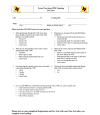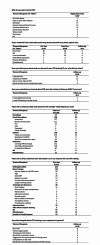Multi-Community Cardiopulmonary Resuscitation Education by Medical Students
- PMID: 32685315
- PMCID: PMC7366050
- DOI: 10.7759/cureus.8647
Multi-Community Cardiopulmonary Resuscitation Education by Medical Students
Abstract
Introduction One purpose of the hands-only cardiopulmonary resuscitation (HOCPR) program is to simplify CPR instruction to encourage more bystanders to take action during cardiac arrest. Although the program has been successfully implemented in traditional classroom settings, the utility of large-scale training events has not been well-explored. We hypothesized that CPR knowledge and comfort levels would increase through a large-scale, multi-community HOCPR training event. We also explored what effect this training event had on perceived barriers to bystander-performed CPR. Methods A convenience sample participated in HOCPR training on a single day across 10 Texas cities. A sub-sample completed training questionnaires, including a five-item CPR pre- and post-test. A follow-up questionnaire was conducted two years after the event. The primary outcome of interest was the difference in cardiopulmonary resuscitation (CPR) knowledge and comfort level between pre- and post-event questionnaires. Demographic contributions were also assessed. Results A total of 4,253 participants were trained, 1,416 were enrolled upon submitting matching pre- and post-event questionnaires, and 101 (14%) submitted follow-up questionnaires. Mean knowledge scores increased from pre-training (2.7 ± 1.6 standard deviation (SD)) to post-training (4.7 ± 0.76 SD) (p < 0.001). Follow-up test scores (3.8 ± 1.1 SD) remained higher than pre-test scores (p < 0.001). Comfort with HOCPR increased from 59% (95% confidence interval (CI) 56 - 61) to 96% (95% CI 95 - 97). Pre- and post-knowledge scores differed significantly by education level (p < 0.001), ethnicity (p < 0.001), and income (p < 0.001). Education contributed significantly to comfort at both pre- (p = 0.015) and post-training (p = 0.026), but ethnicity and income did not. Before training, the most common barrier to performing CPR was lack of knowledge 59% (95% CI 55 - 62); after training, the most common barrier was fear of causing harm 34% (95% CI 29 - 40). Conclusions This study demonstrated that medical students were successfully able to conduct large-scale HOCPR training that improved CPR knowledge and comfort levels among participants across multiple metropolitan areas. Knowledge retention remained higher at two-years for participants of a follow-up questionnaire. Medical students can use the experiences from this training event as a template to organize similar large-scale training events in the future.
Keywords: cardiopulmonary resuscitation; community participation; education; medical students.
Copyright © 2020, Anderson et al.
Conflict of interest statement
The authors have declared that no competing interests exist.
Figures







References
-
- Heart disease and stroke statistics--2018 update: a report from the American Heart Association. Benjamin EJ, Virani SS, Callaway CW, et al. Circulation. 2018;137:0. - PubMed
-
- Outcomes from out-of-hospital cardiac arrest in Detroit. Dunne RB, Compton S, Zalenski RJ, Swor R, Welch R, Bock BF. Resuscitation. 2007;72:59–65. - PubMed
-
- Predictors of survival from out-of-hospital cardiac arrest: a systematic review and meta-analysis. Sasson C, Rogers MA, Dahl J, Kellermann AL. Circ Cardiovasc Qual Outcomes. 2010;3:63–81. - PubMed
-
- Hands-only (compression-only) cardiopulmonary resuscitation: a call to action for bystander response to adults who experience out-of-hospital sudden cardiac arrest: a science advisory for the public from the American Heart Association Emergency Cardiovascular Care Committee. Sayre MR, Berg RA, Cave DM, Page RL, Potts J, White RD, American Heart Association Emergency Cardiovascular Care Committee. Circulation. 2008;117:2162–2167. - PubMed
-
- Comparison of chest compression only and standard cardiopulmonary resuscitation for out-of-hospital cardiac arrest in Singapore. Ong ME, Ng FS, Anushia P, et al. Resuscitation. 2008;78:119–126. - PubMed
LinkOut - more resources
Full Text Sources
